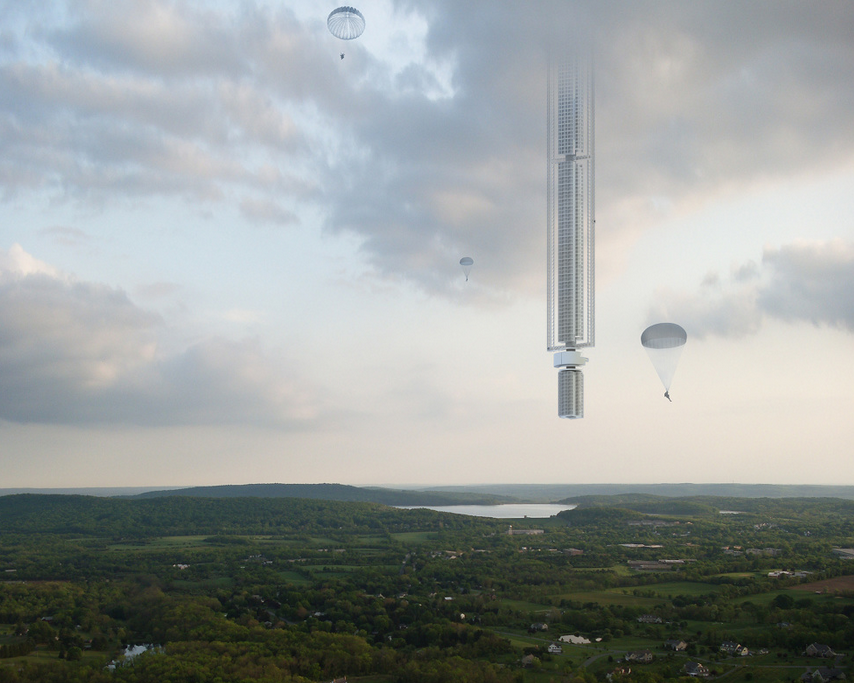By Brian Santo, contributing writer

Image Credit: Cloud Architect Office.
An architectural firm based in New York but with dreams throughout the solar system has proposed the largest residential tower ever: a structure with thousands of stories that would be suspended from an asteroid and would dangle within a few hundred meters of Earth but never touch it.
Clouds Architecture Office calls the structure the Analemma Tower. The name of the tower is the word for the figure-eight path the sun appears to take if you were to map its position in the sky at the same time every day over the course of the year. Due to its geosynchronous (not geostationary) orbital mechanics, the proposed tower would trace a similarly shaped path over the face of the earth.
Clouds AO would like to see the Analemma Tower in New York City — at least for part of the time. The proposed geosynchronous orbit would cause the tower to travel the same route from the East Coast of North America to the West Coast of South America and back every day.
Although the orbital mechanics are well established, the feasibility of juggling asteroids with the complexity of construction remains questionable all before you factor in finance and the law.
The basic proposal is a riff on the notion of the space elevator first theorized by Russian scientist Konstantin Tsiolkovsky in 1895. Tsiolkovsky believed that it would be possible to anchor a tether on Earth that reaches into space. The idea from the start was to use it as a potentially cheaper, safer, and permanent alternative to rocketry to get people and materials back and forth between Earth and orbital space.
Clouds AO is an architectural firm, not a transport company, so its concerns were a little different. “Since humans have emerged from caves, our buildings have been growing ever taller and lighter,” said Cloud AO partner and tower designer Ostap Rudakevych in an email exchange with Electronic Products. “We believe that, someday, buildings will break free from Earth’s surface, releasing us from harmful floods, earthquakes, and tsunamis. Analemma Tower is a speculative idea for how this might be achieved sometime in the future.”

Image Credit: Cloud Architect Office.
One of the obvious ways that the Analemma Tower departs from the space elevator idea is that it would not be tethered to Earth, a design decision that seemingly compromises its value as a conduit for travel and moving materials. Incidentally, that isn’t necessarily the case; Clouds AO has devised an ingenious pivoting docking structure that can be built on solid ground that would link briefly with the lower reaches of the tower on the tower’s figure-eight peregrination past the station every day.
The techniques for diverting asteroids are conceptually developed, Rudakevych noted. Answers about the practicality implementing those concepts would have come from the Asteroid Redirect Mission (ARM) that NASA had been planning for 2021, but that project was scrapped in recent budget plans from the White House.
That hitch in the schedule is unlikely to lead to any significant delays in building the tower, given some of the technological hurdles. Whether it’s a space elevator or a suspended tower, we’re still lacking an essential construction element.
“There are no existing materials strong enough to make a cable to handle the anticipated stresses,” Rudackevych told Electronic Products. “There is progress being made and we hope that, in time, materials science will develop a fiber strong enough for our proposal.”
And then there’s the cost. How much might it cost?
“No idea; it cost $4 billion dollars to build a simple train station downtown , so it’d be a considerable sum,” Rudackevych said. (His reference is to the transit hub at the World Trade Center.)
In their proposal, Clouds AO recommends building the tower in Dubai for cost reasons. The firm calculates that construction cost in NYC would be anywhere from $400 to $600 per square foot. But if the tower were to be built over Dubai — which the architects point out is now the leader in tall building construction — the costs would be only between $27 to $245 per square foot.
Considering that the geostationary orbit is 35,800 km, and the Burj Khalifa structure in Dubai is 0.828 km tall, Cloud AO needs to construct a structure equivalent to 43,000 Burj Khalifas in height, at 3.59 million square feet each. Multiplying through, the Analemma Tower might have 155 trillion square feet times either $245 per square foot or times $400 per square foot.
The dollar differential is enormous. The money saved, however, would no doubt dwarf the cost of dragging an asteroid from one geostationary orbit to another one that is tens of thousands of miles away (as measured from space).
We asked Rudackevych if the construction of the Analemma Tower would raise any interesting legal considerations. “Yes, it does!” he responded. “Citizens of the tower would likely be tax-exempt (certainly from real estate taxes); not sure about border crossings or airspace violations. It’s a big change, so it would require paradigm shifts across the board.” With so many constraints at play, one can’t help but wonder if maybe the Analemma is nothing but vaporware.
Advertisement
Learn more about Electronic Products Magazine





